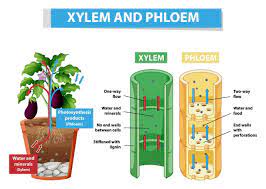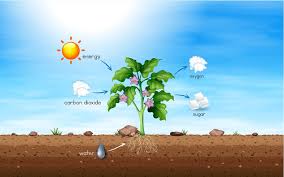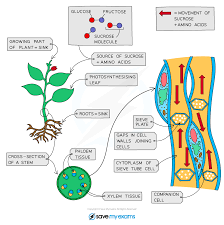When plants create nutrients in their leaves, how do materials get to the rest of the plant? Just as in humans, where food is distributed throughout the body, plants also need to transport the food they create. However, unlike humans, plants don’t consume food the way we do.
Instead, they generate food in their leaves through photosynthesis, where water and carbon dioxide are transformed into carbohydrates that the plant can use for energy. Since photosynthesis only occurs in the leaves, plants must have a system to transport these sugars to other parts of the plant that need them, such as the stems, roots, and flowers.
This process of moving materials from the leaves to other parts of the plant is called translocation. All living organisms, including plants, require energy to carry out daily life activities such as absorption, transport, movement, reproduction, and respiration.
Before energy release occurs, two essential reactions must take place: photosynthesis and respiration. However, in this article, the focus will be on translocation and respiration.
Translocation: Transport of Sugars and Nutrients in Plants
How do sugars and other materials move from the leaves to the areas where they are needed? These materials begin in the leaves, which are known as “sugar sources” because they are abundant in sugar after photosynthesis.
Initially, the sugars must enter the phloem, the plant’s transport system, by one of two methods. In some plants, sugar is directly transported into the phloem using sugar transport proteins.
In others, sugars enter through small openings in the phloem cell walls and are converted into larger forms, preventing them from moving back out. Regardless of the method, this results in a buildup of sugar within the plant system.
The phloem then moves the sugars to “sugar sinks,” areas of the plant such as the stems and flowers that lack sufficient sugar.
Read Also: Factors Affecting the Performance of the Layer Chickens
The Phloem and Xylem Transport Systems

The nutrients created by plants cannot simply flow freely through the plant. They are moved through special tubes known as the phloem. These long, continuous tubes run throughout the plant and extend from the leaves into every part.
New phloem are added as the plant grows, ensuring the flow of nutrients remains uninterrupted. The phloem is not a hollow, open tube but contains xylem tissue, which carries water and dissolved nutrients throughout the plant.
Phloem tubes are essentially a series of connected cells containing xylem, and their connecting walls are sieve-like, allowing materials to pass through freely.
As previously mentioned, sugars move from the leaves to the sugar sinks, which are areas like the stems and flowers that require sugar. Sugars enter the phloem either via sugar transport proteins or through small openings in the cell walls, where they are converted into larger forms to prevent backflow.
Respiration in Plants: Energy Production
Respiration involves breaking down sugars either directly from photosynthesis or from stored compounds like starch or lipids (oils), and using their chemical energy to produce ATP (adenosine triphosphate), the plant’s energy currency.
The respiration process can be broken down into several steps. The first stage is glycolysis, which means “sugar splitting” and occurs in the cytoplasm of the cell. This step doesn’t require oxygen and produces a small amount of ATP. Glycolysis is the central metabolic pathway that other metabolic processes depend on.
It provides essential plant biomolecules such as proteins, lipids, starch, cellulose, DNA, RNA, chlorophyll, pigments, and hormones. The next stages of respiration occur in specialized organelles called mitochondria, where the majority of ATP is released in processes that require oxygen.
Respiration provides the energy needed for all plant life processes, including the synthesis of food through photosynthesis, where light energy is converted into chemical energy stored in carbohydrates like glucose, sucrose, and starch.
Read Also: How To Recycle Different Waste Products
Importance of Respiration in Plant Productivity

Respiration plays a vital role during seed germination when storage proteins, carbohydrates, and lipids in seeds are broken down to support the germinating seedling. The process of aerobic respiration is essential for these stages.
The timing of seed planting is crucial, as temperature and moisture levels significantly impact germination. Respiration increases with higher temperatures, and if soil temperatures are too cold, the respiration rate may be too low to metabolize seed reserves, preventing germination.
High temperatures can slow plant growth because of reduced productivity, usually due to insufficient water for transpiration and CO2 uptake. As temperatures and light levels increase, photosynthesis increases up to a certain point, after which it plateaus due to the finite light absorption capacity of chloroplasts.
However, respiration continues to increase with temperature, leading to higher carbohydrate consumption, which may limit the net photosynthetic product.
The most significant effect of high temperatures on respiration occurs at night, when photosynthesis is inactive. During hot nights, the carbohydrates produced by the plant during the day may be used up in respiration, preventing growth.
Factors Influencing Respiration in Plants
There are several factors that affect the rate of respiration in plants. The following ten factors are important to consider:
1. Type and age of plant tissue: The respiratory rate varies depending on the age and type of plant tissue. Young, actively growing tissues have a higher respiratory rate than older or mature tissues. As tissues age, metabolic processes decrease, and senescence occurs, which increases the respiration rate briefly before the cellular organization collapses.
2. State of respiring protoplasm: The rate of respiration is influenced by the stage of protoplasm development. Actively growing tissues have abundant protoplasm and high enzymatic activity, leading to a higher respiration rate. In mature plant organs, where growth has ceased, the protoplasm contains more inert matter, and metabolic processes slow down.
3. Temperature: Temperature significantly affects the rate of respiration. Lower temperatures (below 10°C) slow respiration, while moderate temperatures accelerate it. However, temperatures above 33°C can decrease the respiration rate, causing a decline in energy production.
4. Hydration of tissues: The amount of water in plant tissues affects respiration. When the moisture content increases, respiration rates also increase. However, when tissues are saturated with water, the respiration rate decreases.
5. Light: Although light is not essential for respiration, it indirectly affects the process by raising the temperature of green plant tissues and increasing the amount of photosynthetic material needed for respiration.
6. Oxygen: Oxygen is essential for aerobic respiration and the Krebs cycle, where oxygen serves as the final electron acceptor. As oxygen concentrations increase, the rate of respiration generally rises.
7. Carbon dioxide: High concentrations of CO2 can inhibit respiration, as seen in germinating pea seeds, where CO2 concentrations above 50% reduce respiration by 50%.
8. Inorganic salts: The rate of respiration increases when plants or tissues are transferred from water to a salt solution, a phenomenon known as salt respiration. This is linked to the absorption of salts and ions, which require energy supplied by respiration.
9. Mechanical stimulation: Physical handling, bending, or stroking of leaves can increase respiration rates. Over time, however, the response decreases, and repeated handling has little effect.
10. Wounding as a respiration stimulator: Wounding a plant organ stimulates respiration, initiating meristematic activity in the region and resulting in wound callus development. This increased respiration supports the tissue’s recovery and healing process.
In conclusion, both translocation and respiration are crucial processes for plant survival, growth, and productivity. Understanding how plants transport nutrients and generate energy helps in optimizing agricultural practices for better crop management and productivity.
Do you have any questions, suggestions, or contributions? If so, please feel free to use the comment box below to share your thoughts. We also encourage you to kindly share this information with others who might benefit from it. Since we can’t reach everyone at once, we truly appreciate your help in spreading the word. Thank you so much for your support and for sharing!

